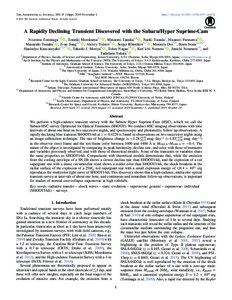A Rapidly Declining Transient Discovered with the Subaru/Hyper Suprime-Cam
Takata T; Tominaga N; Nomoto K; Morokuma T; Kuncarayakti H; Noumaru J; Tanaka M; Moriya TJ; Jiang JA; Blinnikov S; Iwata I; Tolstov A; Doi M; Nagao T; Yasuda N; Furusawa H
A Rapidly Declining Transient Discovered with the Subaru/Hyper Suprime-Cam
Takata T
Tominaga N
Nomoto K
Morokuma T
Kuncarayakti H
Noumaru J
Tanaka M
Moriya TJ
Jiang JA
Blinnikov S
Iwata I
Tolstov A
Doi M
Nagao T
Yasuda N
Furusawa H
IOP PUBLISHING LTD
Julkaisun pysyvä osoite on:
https://urn.fi/URN:NBN:fi-fe2021042821851
https://urn.fi/URN:NBN:fi-fe2021042821851
Tiivistelmä
We perform a high-cadence transient survey with the Subaru Hyper Suprime-Cam (HSC), which we call the Subaru HSC survey Optimized for Optical Transients (SHOOT). We conduct HSC imaging observations with time intervals of about one hour on two successive nights, and spectroscopic and photometric follow-up observations. A rapidly declining blue transient SHOOT14di at z = 0.4229 is found in observations on two successive nights using an image-subtraction technique. The rate of brightness change is +1.28(-0.20)(+0.40) mag day(-1) (+1.83(-0.39)(+0.57) day(-1)) in the observer (rest) frame and the rest-frame color between 3400 and 4400 angstrom is M-3400 (angstrom)-M-4400 (angstrom) = -0.4. The nature of the object is investigated by comparing its peak luminosity, decline rate, and color with those of transients and variables previously observed, and with those of theoretical models. None of the transients or variables share the same properties as SHOOT14di. Comparisons with theoretical models demonstrate that, while the emission from the cooling envelope of a SN IIb shows a slower decline rate than SHOOT14di, and the explosion of a red supergiant star with a dense circumstellar wind shows a redder color than SHOOT14di, the shock breakout at the stellar surface of the explosion of a 25M(circle dot) red supergiant star with a small explosion energy of <= 0.4 x 10(51) erg reproduces the multicolor light curve of SHOOT14di. This discovery shows that a high-cadence, multicolor optical transient survey at intervals of about one hour, and continuous and immediate follow-up observations, is important for studies of normal core-collapse supernovae at high redshifts.
Kokoelmat
- Rinnakkaistallenteet [19207]
